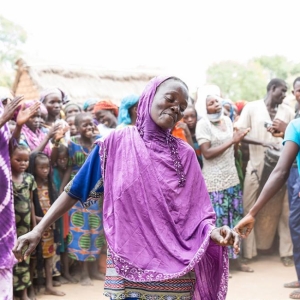Indicators in this domain assess the extent to which migrants have the same status as citizens in terms of access to basic social services such as health, education, and social security. It also describes the rights of migrants to family reunification, to work, and to residency and citizenship. The ratification of the main international conventions is also included within this domain.
Indicators in this category look at the extent to which migrants have access to certain social services such as health, education and social security. They also examine measures to ensure integration and access to work.
Indicators in this domain assess countries’ institutional, legal, and regulatory frameworks related to migration policies. Domain 2 also reviews the existence of national migration strategies that are in-line with development, as well as institutional transparency and coherence in relation to migration management. This domain also investigates the extent to which governments collect and use migration data.
Indicators in this category assess the institutional frameworks of cities for migration. This area also examines the existence of migration strategies consistent with development objectives, as well as institutional transparency and coherence in migration management.
This domain focuses on countries’ efforts to cooperate on migration-related issues with other states and with relevant non-governmental actors, including civil society organizations and the private sector. Cooperation can lead to improvements in governance by aligning and raising standards, increasing dialogue and providing structures to overcome challenges.
Indicators in this category focus on cities’ efforts to cooperate on migration issues with the national government as well as other cities and relevant non-governmental actors, including civil society organizations and the private sector.
This domain includes indicators on countries’ policies for managing the socioeconomic well-being of migrants, through aspects such as the recognition of migrants’ educational and professional qualifications, provisions regulating student migration and the existence of bilateral labour agreements between countries. Indicators equally focus on policies and strategies related to diaspora engagement and migrant remittances.
Indicators in this category assess cities’ initiatives in terms of international student mobility, access to the labour market and decent working conditions for migrant workers. Aspects related to diaspora engagement and migrant remittances are also included in this domain.
This domain studies the type and level of preparedness of countries when they are faced with mobility dimensions of crises, linked to either disasters, the environment and/or conflict. The questions are used to identify the processes in place for nationals and non-nationals both during and after disasters, including whether humanitarian assistance is equally available to migrants as it is to citizens.
Indicators in this category examine the type and level of readiness of cities to deal with aspects of mobility crises. The questions focus on the processes in place for citizens and non-citizens both during and after disasters, especially if humanitarian assistance is available for migrants and citizens.
This domain analyses countries’ approach to migration management in terms of border control and enforcement policies, admission criteria for migrants, preparedness and resilience in the case of significant and unexpected migration flows, as well as the fight against trafficking in human beings and smuggling of migrants. It also assesses efforts and incentives to help integrate returning citizens.
Indicators in this category look at the cities’ approaches to migrant safety as well as return and reintegration policies and the fight against trafficking in persons.
This Profile describes examples of well-developed areas of Municipality of Santiago de Chile (Chile) migration governance structures and areas with potential for further development, as evaluated through the six domains of the Migration Governance Indicators (MGI). These address migrants’ rights, a “whole-of-government” approach, partnerships, socioeconomic well-being of migrants, the mobility dimensions of crises, and safe and orderly migration.
Click the icons on the wheel to explore the key findings.
The Migration Governance Indicators (MGI) initiative is a policy-benchmarking programme led by the International Organization for Migration (IOM) and implemented with research and analysis from the Economist Intelligence Unit. Funding is provided by IOM Member States.
Migration Governance: examples of well-developed areas
- The commune of Santiago implements specific measures to combat discriminatory practices towards migrants in the provision of social services.
- All migrants, regardless of their migration status, can access, on a par with nationals, all the services offered at the Family Health Centres and municipal district medical stations in the commune of Santiago financed by the municipality.
- The Municipal Education Directorate of Santiago de Chile has taken measures to guarantee that foreigners have access to public primary and secondary education.
- The municipality has adopted specific procedures and measures aimed at ensuring the protection of migrant children.
Areas with potential for further development
- No local policy or strategy has been developed to combat hate crimes, violence, xenophobia and discrimination against migrants.
- The development of tools and entities able to raise awareness of migration issues, and the implementation of workshops and training sessions aimed at civil servants providing services to the migrant population are areas for further development.
Migration Governance: examples of well-developed areas
- The Migrant Office of the Santiago de Chile Subdirectorate for Gender Equality, Sexual Diversity and Inclusion is the local entity responsible for the implementation of migration policies.
- The Migrant Office acts as a one-stop shop for optimizing services for migrants with information, guidance and referrals.
Areas with potential for further development
- Although the municipality is advancing on intercultural issues, it still does not have a migration strategy set out in a programmatic document or a manifest.
- No local advisory bodies include representatives of migrant communities providing advice on and monitoring migration-related strategies or programmes.
- Currently, no migration- or migrant-related data are collected or published on a regular basis at the local level.
Migration Governance: examples of well-developed areas
- The municipality of Santiago de Chile collaborates on migration issues with IOM, other United Nations agencies and other international organizations.
- The Migrant Office offers, together with civil society, training in migration management and labour qualifications to which all migrants have access.
- Local authorities occasionally collaborate with the academic world to inform their migration policies and programmes.
Areas with potential for further development
- There is no formal form of cooperation yet between the municipality of Santiago de Chile and the private sector on setting the agenda and implementing migration-related policies and programmes.
- The municipality has not yet joined any bilateral programmes for cooperation between the country’s cities on international migration.
Migration Governance: examples of well-developed areas
- The Migrant Office and the Municipal Labour Intermediation Office implement specific programmes to promote and facilitate the inclusion of migrant workers in the labour force.
- The Migrant Office, through the Santiago Cocina programme, supports and advises nationals, regular migrants and refugees on how to set up businesses in the food sector.
- The municipality of Santiago de Chile, for its part, has initiatives to ensure access to the labour market for the entire population, including regular migrants.
- In terms of financing and entrepreneurship, ad hoc measures have been adopted to support foreign residents.
Areas with potential for further development
- No assessments are undertaken to monitor the local labour supply and the effects of emigration on the local labour market.
- There is room to develop the promotion of ethical hiring of migrant workers, although some action has been taken in this regard – for instance, the provision of specific training on labour issues for municipal personnel and migrants.
Migration Governance: examples of well-developed areas
- The municipality, working through the Migrant Office, deals with humanitarian emergencies.
- The municipality of Santiago de Chile provides information on the evolving nature of crises and emergencies and how to access assistance services through its website and over social networks.
- Local procedures and measures exist for the protection of migrant children.
Areas with potential for further development
- Local strategies for emergency management (prevention, preparation, response and recovery) cover emergencies do not take into account the specific needs of migrants, refugees or internally displaced persons.
- Although the municipality has been part of the Chilean Network of Municipalities for Climate Action (Red Chilena de Municipios ante el Cambio Climático) since 2014, the Network does not emphasize migratory movements caused by the adverse effects of climate change.
Migration Governance: examples of well-developed areas
- The commune of Santiago has specific mechanisms to guarantee that migrants have access to justice, including public security.
- The Migrant Office has teams of social workers who provide guidance on legal assistance to foreigners.
- The local police force receives general training on issues related to the migrant population and human rights.
- Opened in 2014, the Santiago Support Centre for Victims of Violent Crimes, which is operated by the Undersecretariat of Crime Prevention, has an interdisciplinary team that provides remedial services and offers specialized outpatient services to persons who have been trafficked for the purpose of sexual or labour exploitation.
Areas with potential for further development
- The municipality has an agency that handles cases of human trafficking. However, the agency does not have a local anti-trafficking strategy, and the information available is not up to date.
- There are still no local measures to combat labour exploitation.
2022 September




